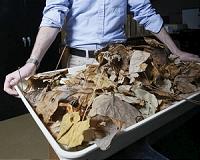| . |  |
. |
Ibadan, Nigeria (SPX) Apr 08, 2011 Low-input farming for cocoa, cassava and oil palm has resulted in widespread deforestation and degredation of West Africa's tropical forest area, according to a new study by researchers at the International Institute for Tropical Agriculture (IITA) and the Center for International Forestry Research (CIFOR). The study was published online this week in the peer-reviewed journal Environmental Management. Cocoa production in West Africa is an important commercial sector and a source of livelihoods for about two million households in the region. For the last 20 years Cote d'Ivoire has been the largest producer both in terms of output and numbers of producers, followed by Ghana, Nigeria, and Cameroon with these four countries now accounting for 70% of global cocoa supply. According to the study, cocoa production in West Africa's Guinean Rainforest region doubled between 1987 and 2007, but most of this increase was fueled by clearing forest areas resulting in large losses of biodiversity and high carbon emissions. The Guinean Rainforest (GRF) of West Africa, identified over 20 years ago as a global biodiversity hotspot, had reduced to 113,000 km2 at the start of the new millennium, which was 18% of its original area, according to the report. The principal driver of this environmental change has been the expansion of low-input smallholder agriculture that depends on environmentally destructive practices like slash-and-burn and land clearing. Researchers at IITA found that increasing fertilizer use on cocoa-timber farms would have spared roughly 2 million hectares of tropical forest from being cleared or severely degraded. On average, farmers are using less than 4kg of total nutrients per hectare in the region. The study suggests that farmers could have achieved the same outputs without rampant deforestation through the intensified use of fertilizer and agrochemicals coupled with improved crop husbandry. According to IITA, by doing so farmers would have doubled their incomes and helped to avoid deforestation and degradation on 2.1 million hectares and in the process, this would have generated a value of over 1,600 million dollars on 1.3 billion tons of CO2 emissions that would not have come from deforestation. The findings should be taken into consideration in discussions around efforts to reduce emissions from deforestation, say researchers. Instead of considering complicated strategies involving monetary or in-kind transfers to farmers or communities for altering their land use behavior, REDD funds could be used to incentivize and promote agricultural intensification efforts that would lead to higher rural incomes, greater food security, and avoided emissions through the achievement of higher agricultural yields. "The limited use of fertilizer may have been logical in 1960, when West African populations were only 25% of today's levels and forestland was still relatively abundant. That choice is no longer tenable in a context where only 15 to 20 percent of the GRF remains," said Gockowski. "There are no longer any frontier forests in West Africa for future generations to exploit," he said. Strategies to reduce deforestation and conserve biodiversity in West Africa must focus on transforming agricultural practices from traditional to modern science based methods. "Fertilizers for forest" technology to sustainably intensify production is available and has achieved impressive cocoa yield increases on a limited scale in parts of the GRF. According to the authors, funding support for reducing carbon emissions due to deforestation and degradation (REDD) to mitigate climate change as discussed in the Copenhagen Accord offers the potential of significant new public resources for needed investments in agricultural research and extension and market infrastructure to support the transformation of traditional agriculture in West Africa. The value of avoided CO2 emissions are conservatively estimated at $565 per hectare for achieving the envisaged doubling of yields. A significant proportion of REDD+ funding should be used to increase the adoption and level of fertilizer use in a "fertilizers for forest" mitigation program. "There is a risk that REDD interventions are only implemented within the forestry sector, while extensive low input agriculture, the fundamental driver of deforestation in the region and the root cause of most rural poverty, gets neglected. This would be a mistake," said Gockowski.
Share This Article With Planet Earth
Related Links International Institute for Tropical Agriculture Forestry News - Global and Local News, Science and Application
 Drought-Exposed Leaves Adversely Affect Soil Nutrients
Drought-Exposed Leaves Adversely Affect Soil NutrientsWest Lafayette IN (SPX) Apr 07, 2011 Chemical changes in tree leaves subjected to warmer, drier conditions that could result from climate change may reduce the availability of soil nutrients, according to a Purdue University study. Jeff Dukes, an associate professor of forestry and natural resources, found that red maple leaves accumulate about twice as much tannin when exposed to hot, droughtlike conditions. Those tannins, w ... read more |
|
| The content herein, unless otherwise known to be public domain, are Copyright 1995-2010 - SpaceDaily. AFP and UPI Wire Stories are copyright Agence France-Presse and United Press International. ESA Portal Reports are copyright European Space Agency. All NASA sourced material is public domain. Additional copyrights may apply in whole or part to other bona fide parties. Advertising does not imply endorsement,agreement or approval of any opinions, statements or information provided by SpaceDaily on any Web page published or hosted by SpaceDaily. Privacy Statement |